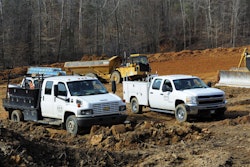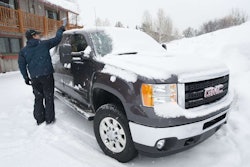Review: Carhartt Work Clothes 
Do your clothes work as hard as your tools? New threads from Carhartt serve you well on any jobsite
by Tom Jackson
(Photos by Bruce W. Smith)
Manufacturers over the last couple of decades have gone to great lengths to make everything from backhoes to cordless drills more efficient, ergonomic and user friendly.
Because of this, today’s construction workers can do a lot more work in less time than guys did years ago.
You might not think of clothing like you do your tools, but that’s what Carhartt is doing with these newest offerings and why they’re worth considering.
With high performance fabrics, sturdy construction and lots of thoughtfully designed storage, the Ketchikan Jacket and Ripstop pants will help you become a more comfortable and productive worker.
Carhartt makes the most functional and durable clothes for construction work. So when I got the opportunity to thrash around in the company’s newest jacket and pants, I was curious as to how they might improve on an already good product.
The Ketchikan Jacket has a 100-percent cotton canvas, waterproof outer shell with taped and waterproofed seams, a hood, front zipper with storm flap closure, two zippered pockets on the sides (also with storm flaps) and two chest pockets, and two interior pockets.
ROOM TO MOVE
There is a waffle knit lining inside, but this isn’t, by itself, a jacket for extreme cold. The qualities that make it breatheable will also let a stiff cold wind pry its way in, as I discovered one frigid evening in Park City, Utah this winter.
But the cut is roomy enough that there’s plenty of space for layering multiple garments underneath. With an additional sweater or vest underneath you can make it as warm as you like, even below freezing, or you can go with a single shirt and work comfortably in temps in the 40s and 50s.
 Carhartt Ketchikan jacket
Carhartt Ketchikan jacket
The sleeve liner is smooth, so it doesn’t bunch up your shirt or sweater when you pull it on—a serious deal-breaker for many other jackets.
In addition to being roomy enough for layering, the cut is such that you get great range of motion, yet the Ketchikan jacket is not baggy. That makes it a lot less likely you’ll get hung on something when you’re climbing on or off a machine.
I also noticed that the numerous pockets are easy to get into, even when you have gloves on.
Carhartt ran the sleeves on this jacket down past the storm cuffs, since customers told the company’s designers the knit cuffs were frequently the first part of the jacket to wear out.
The end of the cuffs, on the jacket I wore, were cut on an angle (longer on the outside of the wrist, shorter on the thumb side) which takes a getting used to.
But the angle cut provides a little extra protection for your wrists and hands, especially when you’re reaching or holding something overhead—a move that typically causes the cuffs on most jackets to pull back and expose your wrists.
WARM AND DRY
Other than my Park City experience, I wore the jacket this winter to do some light logging and clean up at my house and while test-driving new equipment at a recent Cat press event.
Temperatures ranged from the high 30s to low 70s and from sunny and bright to steady drizzle.
As claimed, water beaded up on the surface of the jacket and kept me dry on the inside. And, being breatheable, the jacket didn’t let perspiration build up inside, nor did the jacket get too warm during periods of exertion.
If you work hard in the elements or you’re on your feet a lot outdoors, this is a key benefit.
Gore-Tex will do the same, but it isn’t rugged like Carhartt’s Dura-Dry outer shell, at least not enough to let you shrug off thorns and vines, lie on your back in the gravel or wrestle with concrete, timber and stone.
 I’ve washed the Ketchikan jacket twice now and it still breathes and repels water and looks as good as when it was new.
I’ve washed the Ketchikan jacket twice now and it still breathes and repels water and looks as good as when it was new.
LOOKIN’ GOOD
If you sit in your truck most of the day telling other people what to do, you may not need this jacket. But if your work requires you to hustle when you’re outdoors, the Ketchikan Jacket will do you right.
With the appropriate layering underneath it’s a three-and-a-half season jacket in all but the most severely cold climates.
As a bonus, it’s sharp looking too. I’ve gotten several compliments on it from women, which, given the condition of most of my work clothes, happens rarely. Come to think, that’s never happened before. Available in black and canyon brown. $180.
RIP STOPPERS
Carhartt’s new Cotton Ripstop Pants have the same bullet-proof feel as the jacket and several small details that I liked. Ripstop fabric is woven with a reinforcing yarn running perpendicular to the main weave of the fabric.
If you look closely, the threads form small squares. This literally stops rips, and the technique has been used for tents, kites, parachutes and hang gliders for years. The cloth is also doubled in the front to just below the knees for durability in harsh applications.
The pants sit slightly below the waste with a relaxed seat and thighs and gusseted crotch.
Mine fit comfortably and never felt like they were binding despite a lot of bending, twisting, turning and hill climbing. Like the Ketchikan Jacket, the Ripstop Pants have a trim, military look and they don’t stretch out and get baggy over the course of a day’s work as do cheaper pants.
HOT POCKETS
Where these pants prove exceptional is the design of the pockets. Blue jeans pockets are typically horizontal and it can be difficult to get stuff out of them if you’re wearing gloves.
On the Carhartt Cotton Ripstop pants, the more vertical slant of the front pockets enables you to reach the bottom singlehandedly, even with gloves on.
That may not be a big deal for some people, but if you have a drill chuck key, an allen wrench or some other object you need to dig out of your pockets frequently, this can help make you more efficient and/or keep one hand free for other demands.
The pockets also have a Cordura reinforced horizontal “ledge” which makes it easy to secure a folding knife, tape measure or other small objects with clips.
In the past I’ve avoided cargo pants because the side pockets were typically so baggy that they didn’t hold tool securely.
When you walked, the tools tended to flap around. Climb a ladder and tools were likely to fall out. And I avoid tool belts when I can. They’re cumbersome and they tend to accumulate junk.
But the Carhartt cargo pockets are flat enough to hold small hand tools securely. I was able to avoid using a tool belt and yet keep all the tools I needed for a half-day of wiring projects in the cargo pockets.
I also did a little work under the hood of my truck, and having the wrenches in one cargo pocket where I could reach them without looking was a lot more convenient than putting them on the ground or on a cart.
Another nice touch: the pockets are lined with Cordura, so screwdrivers, box knives and other tools with sharp edges won’t poke holes in them.
Hammer loops on both sides, and another tighter loop on each side, make it possible to hang just about anything with a clip on it to either leg. The pants come in moss, desert, black and dark coffee. $55.
Looking good is just icing on the cake, but also important if you have to rush from the field to a presentation or sales call without enough time to change.








